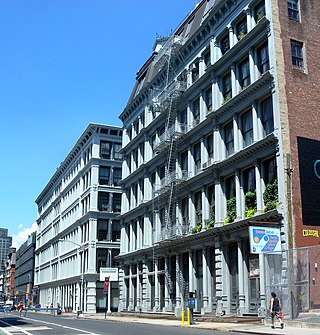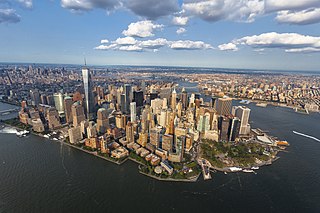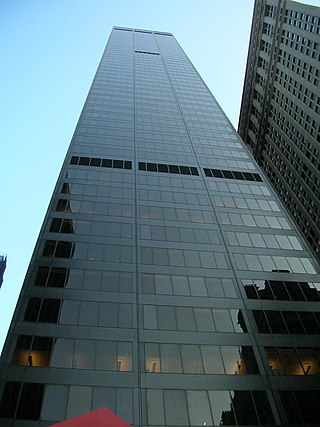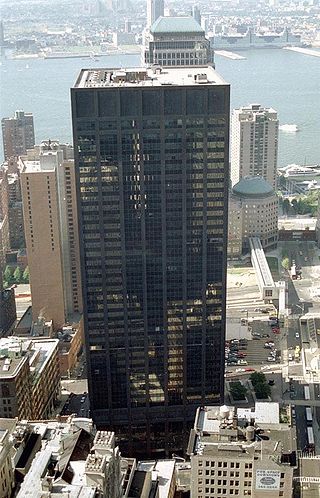
SoHo, sometimes written Soho, is a neighborhood in Lower Manhattan, New York City. Since the 1970s, the neighborhood has been the location of many artists' lofts and art galleries, and has also been known for its variety of shops ranging from trendy upscale boutiques to national and international chain store outlets. The area's history is an archetypal example of inner-city regeneration and gentrification, encompassing socioeconomic, cultural, political, and architectural developments.

The Triangle Shirtwaist Factory fire in the Greenwich Village neighborhood of Manhattan, New York City, on Saturday, March 25, 1911, was the deadliest industrial disaster in the history of the city, and one of the deadliest in U.S. history. The fire caused the deaths of 146 garment workers – 123 women and girls and 23 men – who died from the fire, smoke inhalation, falling, or jumping to their deaths. Most of the victims were recent Italian or Jewish immigrant women and girls aged 14 to 23; of the victims whose ages are known, the oldest victim was 43-year-old Providenza Panno, and the youngest were 14-year-olds Kate Leone and Rosaria "Sara" Maltese.

Tribeca, originally written as TriBeCa, is a neighborhood in Lower Manhattan in New York City. Its name is a syllabic abbreviation of "Triangle Below Canal Street". The "triangle" is bounded by Canal Street, West Street, Broadway, and Chambers Street. By the 2010s, a common marketing tactic was to extend Tribeca's southern boundary to either Vesey or Murray Streets to increase the appeal of property listings.

Lower Manhattan, also known as Downtown Manhattan or Downtown New York, is the southernmost part of Manhattan, the central borough for business and culture. The neighborhood is the historical birthplace and serves as the seat of government of New York City. Because there are no municipally defined boundaries for the neighborhood, a precise population cannot be quoted, but several sources have suggested that it was one of the fastest-growing locations in New York City between 2010 and 2020, related to the influx of young adults and significant development of new housing units.

The Equitable Building is an office skyscraper located at 120 Broadway between Pine and Cedar streets in the Financial District of Lower Manhattan in New York City. The skyscraper was designed by Ernest R. Graham in the neoclassical style, with Peirce Anderson as the architect-in-charge. It is 555 feet (169 m) tall, with 38 stories and 1.2 million square feet (110,000 m2) of floor space. The building's articulation consists of three horizontal sections similar to the components of a column, namely a base, shaft, and capital.

140 Broadway is a 51-story International Style office building on the east side of Broadway between Cedar and Liberty streets in the Financial District of Manhattan in New York City. The building was designed by Gordon Bunshaft, of the firm Skidmore, Owings & Merrill, and consists of a mostly smooth black facade on a trapezoidal plot. It is approximately 688 feet (210 m) tall, with approximately 1.17 million rentable square feet (109,000 m2). It is known for the distinctive sculpture at its entrance, Isamu Noguchi's Cube.

The Deutsche Bank Building was a 39-story office building located at 130 Liberty Street in Manhattan, New York City, adjacent to the World Trade Center site. The building opened in 1974 and closed following the September 11 attacks in 2001, due to contamination that spread from the collapse of the South Tower. The structure was designed by Shreve, Lamb & Harmon, which also designed the Empire State Building.

The St. Paul Building was a skyscraper in the Financial District of lower Manhattan in New York City at 220 Broadway, at the southeast corner of Broadway's intersection with Ann Street. Designed by George B. Post and completed in 1898, it was one of the tallest skyscrapers in New York City upon its completion, at 26 stories and 315 feet (96 m).

The American Surety Building is an office building and early skyscraper at Pine Street and Broadway in the Financial District of Manhattan in New York City, across from Trinity Church. The building, designed in a Neo-Renaissance style by Bruce Price with a later expansion by Herman Lee Meader, is 388 feet (118 m) tall, with either 23 or 26 stories. It was one of Manhattan's first buildings with steel framing and curtain wall construction.
The Weylin Hotel was a hotel at 527 - 531 Madison Avenue and 40 - 54 East 54th Street in New York City. It was on the southeast corner of 54th Street. The structure was sixteen stories tall and opened in March 1921. The building fronted sixty-one feet on Madison Avenue and one hundred forty-eight feet on 54th Street. It contained 125,000 square feet (11,600 m2) of space.
The Dauphin Hotel was an establishment located on the west block front of Broadway between 66th Street and 67th Street on the Upper West Side of Manhattan in New York City. In 1958, the ballroom of the hotel was behind Julia Murphy's Bar. The Dauphin Hotel was demolished as part of the excavation for the Lincoln Center for the Performing Arts. By 1964, the site was taken by the Empire Mutual Insurance Group building. This edifice also occupied the space where the Marie Antoinette Hotel previously stood. The area is currently occupied by a variety of retail stores including Raymour & Flanigan, Zara, and Pottery Barn, as well as a residential building.

The Marbridge Building is an office building at 1328 Broadway, on the east side of Sixth Avenue between 34th and 35th Streets in Herald Square, Manhattan, New York City. It opened in 1909, an 11-story structure, utilized in part by men's clothier Rogers Peet. Until October 1910 it stood opposite the Alpine apartment house, which was at the northeast corner of Broadway and 33rd Street. The Alpine and old stores between 33rd and 34th Streets were demolished to make room for the $5,000,000 Hotel McAlpin near the end of 1910. On the other side of Broadway were located the Macy's Herald Square and Saks Incorporated stores, with the Gimbels store just below.
The Studebaker Building is a former structure at 1600 Broadway on the northeast corner at 48th Street in Manhattan, New York City. It was erected by the Juilliard Estate, in 1902, between Broadway and 7th Avenue, in the area north of Times Square. It was demolished in 2004 to make room for an apartment tower, a twenty- five story, 136 unit, luxury condominium designed by architect Einhorn Yaffee Prescott.
The Detmer Woolen Company was founded in 1885 in New York City by Julian Francis Detmer. The business dealt primarily with textile mills in New England. Detmer was a native of Cleveland, Ohio who came to New York City and started a woolens wholesale and importing firm. He was president of Detmer & Moore, Detmer & Richter, the Detmer Woolen Company, and Detmer, Bruner and Mason.
The Appleton Building occupied the front of a small block which was bounded by Broadway, Leonard Street, and Catharine Alley in New York City. It stood on the site of what is now 346 Broadway, was four stories tall, and was constructed entirely of brown stone. It was a familiar landmark in a quickly changing Broadway of the mid-19th century. It was one of Broadway's oldest buildings.

108 Leonard, formerly known as 346 Broadway, the New York Life Insurance Company Building, and the Clock Tower Building, is a residential structure in the Tribeca neighborhood of Manhattan in New York City, United States. Built from 1894 to 1898, the building was constructed for the New York Life Insurance Company. Stephen Decatur Hatch created the original plans while McKim, Mead & White oversaw the building's completion. The building occupies a city block bounded by Broadway to the west, Leonard Street to the north, Lafayette Street to the east, and Catherine Lane to the south. It is a New York City designated landmark and is listed on the National Register of Historic Places.

The City Investing Building, also known as the Broadway–Cortlandt Building and the Benenson Building, was an office building and early skyscraper in Manhattan, New York. Serving as the headquarters of the City Investing Company, it was on Cortlandt Street between Church Street and Broadway in the Financial District of Lower Manhattan. The building was designed by Francis Kimball and constructed by the Hedden Construction Company.

The New Era Building is an 1893 Art Nouveau commercial loft building at 495 Broadway, between Spring Street and Broome Street, in the SoHo section of Manhattan in New York City.

The Bumiller Building is a residential building in the Los Angeles Historic Broadway Theater District. Built in 1906 and designed by the architects Morgan & Walls, the Bumiller Building was constructed of reinforced concrete in Renaissance Revival style. Historically the building has been a department store and a theater.

The Home Life Building, also known as 253 Broadway, is an office building in Lower Manhattan, New York City. It is in Manhattan's Tribeca and Civic Center neighborhoods at the northwest corner of Broadway and Murray Street, adjacent to City Hall Park.














